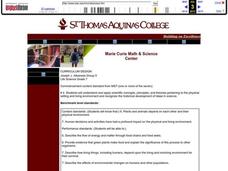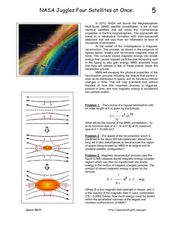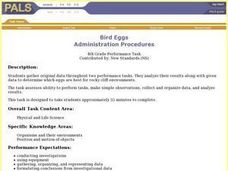PBS
The Planets of the Solar System
Launch a lesson that's sure to capture middle schoolers' interest! Exploration enthusiasts examine the planets of our solar system using an activity from PBS's Space series. The resource includes images and information for each planet,...
Teach Engineering
An Inflated Impression of Mars
Help your class understand the magnitude of the distance between Earth and Mars with an activity that asks small groups to use balloons to create scale models of the Earth, Moon, and Mars. Class members figure out the distances...
Curated OER
Measuring Speed in the Universe
For this measuring speed in the universe worksheet, students use photographs of 3 astronomical phenomena including supernova explosions, coronal mass ejections and solar flare shock waves to find how fast they move. The photographs show...
Curated OER
Hierarchy Theory and Biotic Hierarchy
Pupils examine the hierarchy theory and biotic organization by playing a teacher-created card game matching groups of items, such as organelles, in suits of four. They discuss the reasons for their hierarchical organization of the biotic...
Curated OER
Math Skills: Conversions
In this conversions activity, learners use metric unit conversions to solve fifteen word problems that involve converting from one unit to another.
Curated OER
Scale of Organisms
In this scale worksheet, students use the SI system to compare the sizes of some of the smallest and largest organisms on Earth. This worksheet has 7 problems to solve.
Curated OER
Star Magnitudes and Multiplying Decimals
In this star magnitude and multiplying decimals worksheet, learners solve 5 problems using the magnitudes of given stars to determine which stars are the brightest, they determine the magnitude differences of stars and they sort given...
Curated OER
Plants and Animals
Seventh graders discover the interconnectedness of plants and animals in ecosystems. In groups, they create a food web and discuss the problems when one link of the chain is broken. To end the lesson, they set up a balanced environment...
Curated OER
Investigate Factors Affecting Nitrates in Groundwater
Young scholars participate in an experiment in which they investigate the factors affecting the levels of nitrates in groundwater. Using examples, they explain the nitrogen cycle and identify the sources of chemical nitrogen...
Curated OER
Hedgerows
Hedgerows prevent soil erosion, capture pollutants running off fields, store carbon to help combat climate change, and provide homes for predators of many pest species. The biodiversity lesson begins with an activity that...
Curated OER
The Big Bang-Cosmic Expansion
In this Big Bang worksheet, learners are given the equation used to determine the rate at which the universe is expanding according to the Big Bang theory. Students solve 4 problems using this equation. They find the integral for time,...
Science 4 Inquiry
An Investigative Look at Florida's Sinkholes
In May of 1981, the Winter Park Sinkhole in Florida first appeared and is now referred to as Lake Rose. Scholars learn about the causes of sinkholes through an inquiry project. Then, they analyze recent data and draw conclusions to...
Cornell University
Shedding a "Little" Light on Cancer Surgery
Many types of cancer treatments now depend on nanotechnology—a big "little" discovery. Scholars begin by removing "malignant" tissue from simulated brains, one using fluorescent markers thanks to nanotechnology and one without. This...
Curated OER
Power Functions: A Question of Magnitude
In this power functions worksheet, students read about determining the brightness of stars using a magnitude scale. Students solve 4 problems including finding the magnitude differences of stars and determining equivalent magnitudes.
Curated OER
Life Science: Heavy Weight
High schoolers investigate adolescent obesity and its health impact. In this health and obesity instructional activity, students research the problem, develop a survey regarding eating habits, then analyze the nutritional information on...
Curated OER
NASA Juggles Four Satellites at Once
In this NASA satellites worksheet, students read about the Magnetosphere Multi-Scale satellite constellation that NASA will launch in 2013. They solve 4 problems including finding the volume of the MMS constellation, finding how long it...
Curated OER
SI Units and Conversions Between Them
In this SI units and conversion worksheet, students are given five problems to solve. They convert from one SI unit to another.
Curated OER
Water Cycle
Ninth graders explore ways water moves through various reservoirs on Earth, examine how human activities change water cycle, investigate substances present in water that indicate human activity, and discuss how understanding water cycle...
Curated OER
Bird Eggs
Learners perform an experiment with different types of bird eggs to determine what factors make them strong and able to stay on a cliff without rolling off.
Learning Games Lab
Testing and Adjusting pH
Pupils learn how to control food spoilage by adjusting the food's pH. They see that one of the most dangerous bacteria can grow in food if people don't handle and store food properly. Using knowledge of the bacteria's preferred pH,...
Curated OER
Layering the Air
Students study the layer of the atmosphere. In this lesson on the atmosphere, students discuss the composition of the air around us and how the atmosphere was formed. Students create a scale model of the layers of the atmosphere.
Curated OER
Rainforests of Madagascar: Role Playing and Decision Making
Students examine reasons for deforestation and become familiar with Madagascar and its culture, while describing biological and abiotic components of a rainforest, and looking at aspects that must be addressed to resolve the issue of...
NASA
Star Brightness
In this brightness of stars learning exercise, high schoolers answer 7 questions about the apparent magnitudes of stars, the sun, and the moon. They compare the brightness of stars, galaxies, astronomical objects and the sun.
Curated OER
The Environment and Interactions of Living Organisms
Young scholars study the environment and interactions of living organisms. They identify abiotic and biotic factors and create a foldable and vocabulary cards. They create a poster illustrating soil and watch a video to study symbiosis.























